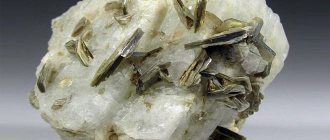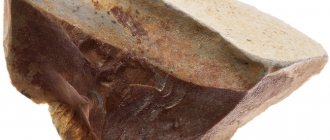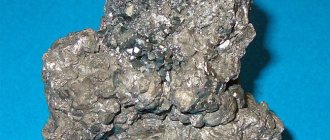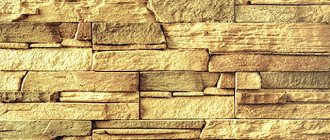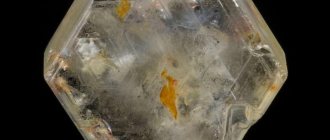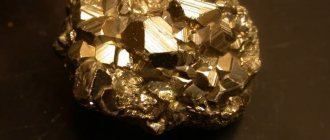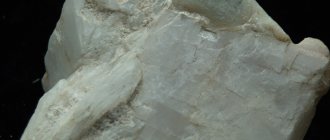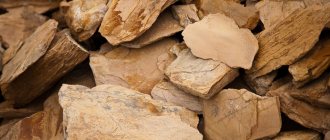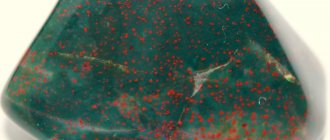History and origin
Translated from Greek, pyrite means “stone that creates fire.” It received this name for its ability to spark when struck. This useful feature placed the lighter mineral above gold.
Pyrite
The Incas of pre-Columbian America used a stone with shiny edges as a magic mirror; the Indians considered it an amulet against alligators.
Pyrite clouded the minds of the Spanish conquistadors: mistaking the mineral for gold, they took it from local residents by force or deception. And in their homeland they were made fools by showing off the pyrite gold of the Incas under the guise of a noble metal.
Prospectors from the Alaska Gold Rush were in trouble. Thus, the names “Inca gold” and “fool’s gold” were assigned to pyrite.
The mineral “golden” pyrite was exalted during the reign of Napoleon. It was awarded to ladies who donated jewelry to the fighting army. It was a badge of honor; patriotic French women were proud of such accessories.
The 20th century was a turning point for the mineral. British designers Butler and Wilson were visited by fresh ideas, their exclusive products became very popular and made the “golden” stone a favorite of bohemia.
Pyrite is formed as a result of magmatic or hydrothermal processes, at the bottom of closed sea basins, in the copper-nickel formation.
Igneous rocks are rich in small crystals; the largest cubes hide quartz veins.
Origin of pyrite
It is no coincidence that the name pyrite means “carving fire.” The fact that the mineral can be used as a primitive “lighter” was known already in the Stone Age: its properties are such that when struck correctly, the gem gives a good spark.
In Europe, by the 16th century, flint deposits had already been exhausted, but in Central and South America they were not. But when the conquistadors found bright yellow stones, loaded them onto ships and sent them home, educated people laughed at them. To be fair, the notorious “Inca gold” did exist, but sulfur pyrites had nothing to do with it. During the Gold Rush, prospectors also confused the mineral with gold ore. This is probably where “fool’s gold” came from.
In the seventeenth century, the fire mineral became fashionable among jewelers. They were used to highlight the beauty of diamonds, and also to make independent jewelry from the mineral. Under Napoleon, flint and steel were given to women who donated their gold to the needs of the army. So the stone also became a symbol of patriotism, sacrificial love for the homeland.
In the 20th century, inserts imitating gold began to be made from pyrite. To this day it is loved because it is both cheap and beautiful. As for the properties of knocking out fire, here they have been replaced by lighters and matches, although no one is stopping you from trying.
Physicochemical characteristics
Pyrite is the most common sulfide. The crystal cubes have smooth edges and seem to have a hatched pattern on the surface.
| Formula | FeS2 |
| Color | Straw yellow, brass yellow, golden yellow, sometimes tarnished |
| Shine | Metal |
| Transparency | Opaque |
| Hardness | 6-6,5 |
| Cleavage | Very imperfect by {001} |
| Kink | Conchoidal |
| Density | 5.01 |
The hue and luster are visually identical to gold or silver, which once puzzled mineralogists. They spent a long time deciding whether it was stone or metal.
Pyrite stone
The dominance of sulfur and iron, as indicated by the chemical formula of the substance, led to other names for pyrite - sulfur pyrite and iron pyrite.
What is pyrite: composition, formula and structure
This mineral is iron disulfide, its chemical formula is FeS2. However, it is almost impossible to find it in such a “pristine” form. Pyrite always contains an “addition” of arsenic, cobalt, copper, selenium and other minerals.
There are varieties of stone - bravoite and marcasite. The formula of pyrite does not change in both cases, but bravoite includes about 20% nickel. Marcasite, or radiant pyrite, can contain thallium, bismuth, arsenic, and copper. It is also called “drop silver”. It differs from “classical” pyrite in its crystal lattice structure.
Iron pyrite (another name for pyrite) is not very strong, with a hardness on the Mohs scale of 6 to 6.5. It quickly oxidizes when in contact with oxygen and turns into limonite (the general name for some mineral aggregates).
The crystal lattice of the mineral pyrite is face-centered cubic. Depending on the presence of certain elements, crystals take the form of pentagondodecahedrons, cubes, and octahedra.
Place of extraction
Pyrite is found almost everywhere on the planet. The largest deposits of the mineral are in Russia (Ural) and the USA. Small accumulations are found in Europe.
Specimens in condition suitable for processing and use are rare. Almost everything is supplied by Italy. In South Africa, material with uranium impurities is mined.
The shine of pyrite layers means the presence of gold nearby. This proximity makes the mineral look like a noble metal.
Pyrite can be found near hot springs. The stone is not mined separately, but is extracted from ore containing cobalt, zinc or copper.
Place of Birth
There are quite a lot of deposits of the mineral pyrite on Earth, but specimens with jewelry properties are found quite rarely. The stone is mined in Scandinavia, Azerbaijan, the USA, and the Urals. Beautiful minerals are often found in Italy.
Pyrite crystals are most often found near hot springs, sulfur or gold deposits. Hence its second name - gold or sulfur pyrite, although technically pyrite is an ore, not a gem.
When copper, nickel, or zinc are smelted from ore, the “by-product” is also often individual crystals of fire rock. Beautiful and large specimens are found when mining quartz veins.
Varieties and colors
Pure sulfur pyrite is rare. More often, impurities create a range of stones from barely noticeable yellowish to golden yellow.
Types of mineral:
- bravoite - thick yellowness comes from nickel (up to 20% of the composition), a jewelry variety;
Bravoite mineral - marcasite - metallic shiny “drop silver” plus shimmer on a slightly yellowish background; It oxidizes easily, so it is not suitable for jewelry.
Mineral marcasite
Visual differences are created not only by impurities, but also by the lattice structure. Thus, marcasite is characterized by syngony, so the crystals resemble rays.
Distribution of mineral in the earth's crust
The origin of sulfur pyrite deposits is usually geothermal, less often sedimentary. Most often, the mineral is formed in closed seas during the precipitation of iron by hydrogen sulfide. Sometimes its inclusions can be found in igneous rocks.
In sedimentary rocks, pyrite quite often replaces the remains of dead plants and even animals. This is how unusual fossils are formed - shells, branches, fragments of bark, etc. An unusually interesting, but creepy find was discovered in Sweden at the end of the 18th century: a miner who died 60 years ago was found there, whose body was almost completely replaced by pyrite.
Pyrite deposits are located almost everywhere around the globe. The most famous of them are located in Kazakhstan, Russia, Italy, USA, Canada and Norway. As a rule, this mineral is extracted from the bowels of the earth along the way, in the process of extracting other, more valuable minerals.
A non-jewelry quality pyrite nugget weighing 1 kg costs about $30 on the market. But for a processed piece of mineral of the same weight you will have to pay 3-4 times more money.
Medicinal properties
The external resemblance to gold determined the healing properties of the stone.
Pyrite heals the soul and body, acting on a deep level. It cleanses and strengthens the human biofield, so even severe or chronic illnesses recede.
The mineral is applied to the problem area, from which it “pulls” bad energy. Helps with the following problems:
- infertility;
- infections, viruses;
- joint pain;
- skin fungus;
- freckles;
- cataract;
- decreased muscle tone.
By accelerating blood circulation, the stone stimulates the functioning of the cardiovascular system and lungs. Healers advise tying it to a woman’s leg to facilitate childbirth.
The mineral improves sleep and performance; it is suitable for people with a hectic pace of life or those engaged in routine hard work.
This is a natural antidepressant, but overly emotional people need to be careful with it.
Applications of pyrite
Pyrite jewelry is usually made from Italian examples - they are the largest and most beautiful. Ordinary jewelers are rarely interested. Most often, jewelry pyrite is used to make cufflinks, rings with inclusions, and buttons. Other minerals do not combine well with it.
The stone is used in industry - iron ore and sulfur are extracted from it. At the same time, the process of burning pyrite is very dangerous - the stone has strong oxidizing properties and burns well. In mines, when huge masses of pyrites oxidize, fires can occur.
If jewelers sometimes turn up their noses, the magical properties of the pyrite stone attract the attention of psychics and occultists from all over the world. Amulets and talismans are made from the mineral. Such a talisman does not live long compared to others, but this only gives it a special charm.
Magic properties
Roman legionnaires and Greek warriors considered pyrite theirs. It was believed that this stone was the earthly embodiment of the god of war, Mars, and an amulet with it made the owner brave and protected from wounds.
The magical properties of the stone are also valued in the peaceful sphere. Sorcerers, psychics, and their other practicing colleagues do not skimp in order to take possession of an impeccable copy. Only a pebble with a smooth, solid surface, without chips or cracks, restores strength. Defective minerals attract problems.
Shiny pyrite crystals are powerful helpers for various purposes:
- peace of the family hearth, revival of marital feelings;
- success on the love front;
- eliminating conflicts at work and at home;
- protection from the elements;
- energy supply at the mental and physical levels;
- concentration for action in extreme situations.
Pyrite amulet
Pyrite cubes are talismans and amulets for people in risky professions: police officers, emergency workers, hot shop workers, firefighters, stuntmen. The owners of such a talisman become calmer and more resilient.
The stone is suitable for real and potential leaders.
However, this is a “highly moral” mineral; its magic only helps in actions with a plus sign. Liars, cunning people, dishonest people risk having the negative message sent back. In a favorable scenario, the value of the stone for them will be zero.
Talismans and amulets
Pyrite bracelet
Pyrite is a unique amulet for people whose professions involve risk to life. These are firefighters, construction workers, and military personnel.
Talismans made from the mineral will protect them from danger. It is also recommended to be worn by those associated with the law. The stone will help you make fair decisions.
A mineral amulet will protect the house from enemies and ill-wishers. In love magic, a pyrite talisman can attract love and rekindle faded feelings.
Practicing magicians use the stone as an energy restorer after magical sessions, and also use it to make deals with evil spirits.
Who is suitable according to their zodiac sign?
Energetically strong pyrite is patronized by the powerful Mars and Neptune. Not every zodiac sign can use the stone.
If a person’s work is monotonous or calm, but according to the horoscope there are no obstacles, moderate use of the stone is acceptable.
| Zodiac sign | Compatibility |
| Aries | +++ |
| Taurus | + |
| Twins | + |
| Cancer | — |
| a lion | +++ |
| Virgo | + |
| Scales | + |
| Scorpion | + |
| Sagittarius | +++ |
| Capricorn | + |
| Aquarius | + |
| Fish | + |
(“+++” – fits perfectly, “+” – can be worn, “-” – is strictly contraindicated)
Pyrite and Zodiac
Pyrite by name and appearance resembles gold and fire. Therefore, astrologers consider it suitable for Leo born in the summer, as well as the fire sign Aries. These people are endowed with a reserve of energy, so the stone, even with prolonged interaction, will not harm them. Suitable for hardy, strong Sagittarius or Scorpio.
It will help Scorpios or Geminis in moving up the career ladder. Other signs of the Zodiac do not need the mineral, because it can suppress, even devastate. Representatives of the element of Water - Cancers or Pisces - will be completely “dried up”, drawing out all their strength.
People whose profession does not involve risk or whose zodiac sign is anything other than Leo, Aries, Sagittarius, Scorpio should wear the stone with caution.
Pyrite is very strong energetically, returning health and thirst for life to the owner. Such power, according to astrologers, is associated with Mars and Neptune, who patronize the stone.
Compatibility with other stones
Pyrite is a mineral of the fire element. Of the precious and semi-precious stones, only hematite and serpentine can be neighbors in jewelry or a box. The rest will be crushed by the powerful energy of the “golden” mineral.
For those who are indifferent to the magical properties of natural pyrite, jewelers offer multi-colored jewelry. In them, pyrite inserts or elements are aesthetically complemented with inexpensive gems: pressed turquoise, cultured pearls, garnet, jasper.
Products and decorations made of pyrite
Pyrite ball on a stand
Despite the abundance of the mineral in nature, as well as the low cost of its extraction, jewelry with pyrite is highly expensive, especially if made of precious metals:
- a silver ring with an insert will cost from $300, a solid pyrite ring will cost from $350, and a gold ring will cost from $1,500;
- prices for earrings range from $300-500;
- bracelets starting at $20;
- beads will cost $100-150.
Despite the high cost, such jewelry is popular. Although the prices of simpler jewelry stores are an order of magnitude lower than the cost of jewelry from designer houses. And costume jewelry will generally cost the buyer a ridiculous amount, since pyrite itself is an inexpensive mineral, and many alloys for costume jewelry are affordable.
Application and Use
The physical properties of pyrite determined the areas of its use.
Industry
The main field of application of the stone. The mineral is used in the production of concrete, iron sulfate, cement, mastics, and steel.
Once upon a time, alchemists deceived powerful patrons with a “golden” stone. Modern adherents of this science are not interested in him. The idea of extracting gold from pyrite is utopian: it was found that there is as much of it as in the human body.
Jewelry
The material used in jewelry is structurally flawless and effective.
It is used to make pendants, necklaces, bracelets, and earrings for women. They are appropriate in the office, at a party or for a walk. The frames are bronze, brass, jewelry alloy and cupronickel.
Crystalline pyrite is a fertile material for men's assortment. A bracelet, pendant or pendant with minimal stone processing is truly brutal sophistication.
Collection material
Minerals with tarnish are prized by collectors. This is a real rainbow stone - it shimmers with all the colors of the solar spectrum. For example, copper impurities give a blue tint.
Pyrite bracelet
Yellow, green, brown fragments on the surface are the result of other elements in the composition of the mineral.
Price
Pyrite is inexpensive and is priced per gram or kilogram. The price of the product depends on the degree of processing:
- non-jewelry raw materials - $22–26 per kg;
- tumbling 12–45 mm – $40–45 per kg;
- beads about 40 cm long - $11 (2 mm), $8 (6 mm);
- figurine 15x8 cm - $200–250.
The ornamental mineral is difficult to process, so small beads are more expensive than large ones.
Use of pyrite in industry
Pyrite is used as a raw material for the production of various chemicals: sulfur, sulfuric acid, iron sulfate. True, these days sulfur pyrites are used less and less in this way. It is more widely used in the production of mastics, cement, and certain types of concrete, acting as a “corrector.”
Pyrite is mined in huge quantities from deposits of non-ferrous metals, but extracting it from the rock is unprofitable. Iron pyrite obtained as a by-product is sent to dumps.
In the past, pyrite was used in the manufacture of flint guns and pistols. At a later time, the mineral played the role of a detector diode in radio receivers. This is explained by the fact that most of the current passes through it in only one direction.
When pyrite ore is roasted, cinders are obtained, from which iron is isolated or paints are made. This may be due to the formula of pyrite - it contains 47% iron and 53% sulfur.
In chemistry, pyrite is used to purify gaseous substances from chlorine.
How to spot a fake
The cost of pyrite is affordable, but instead they offer plastic or glass with a shiny coating. In turn, the mineral is passed off as gold.
It is easy to distinguish pyrite from imitation:
- Evaluate for clarity. A real mineral is always impenetrable.
- Scratch the sample with your fingernail. Spraying on the imitation will do.
- Run the sample across the glass. Pyrite will scratch it without any problems.
To avoid buying a stone at the price of gold, just press on the surface or try on your tooth. Soft gold will leave a dent; hard pyrite does not have this property.
Shambhala made of pyrite
The characteristics of the mineral exclude fine processing. Jewelry made from pyrite is not elegant and filigree. They're rough, but they look great. This differentiates processed pyrite from gold or plastic.
Caring for mineral products
Despite its hardness, the mineral is very fragile and vulnerable. It must be handled with extreme care and delicacy. Pyrite rings are especially vulnerable. They are afraid of moisture (like all authigenic, that is, sedimentary, structures). High temperatures and shocks have a bad effect on them.
There is no need to be afraid of spontaneous combustion of pyrite, as in mines, but it is still advisable to keep it away from open fire. Accept in advance that products made from pyrite will not last you long: within five to six years, the talisman will begin to lose its noble shade.
To preserve the stone better, you can coat it with varnish.
Some collectors collect rare specimens, such as "rainbow stones." Despite their beauty, they still retain their fragile properties. If water gets on the crystal, it will react with it to form sulfuric acid. It is unlikely that you will be able to completely seal your valuable specimens, but you can boil them in paraffin to prevent moisture from entering.
How to wear and care
The energy of the stone is such that strong-willed people can constantly interact with it.
For the rest, esotericists recommend wearing jewelry for no more than three days in a row. Otherwise, a nervous breakdown, irritability, even insanity are guaranteed.
The mineral is delicate; the following are contraindicated:
- falls, mechanical impacts;
- prolonged exposure to the sun;
- household chemicals;
- proximity to other stones.
Even ordinary conditions are not suitable: within a few years, untreated pyrite crumbles in air. This is probably where the legends about old pirate treasures that became dust came from. The earth or deep sea destroys the mineral faster.
For safety, experts recommend covering dry items or crystals in jewelry that are free of oxides and dirt with colorless nail polish or soaking them in vegetable oil. Owners of pyrite items say that in this form they retain their original appearance and last for many years
.
Caring for collectible exhibits is troublesome. Oxygen in the air decomposes the mineral, and water that gets on the stone creates sulfuric acid, which is destructive to the exhibit.
Pyrite bracelet
Therefore, it is better to store fossils with pyrite in vacuum packaging. It's expensive and not available to everyone. It is cheaper, following the example of museum workers, to boil it over low heat in paraffin or rosin. The procedure can be done at home, but only a vacuum provides a complete guarantee of the safety of structurally heterogeneous samples.
How to care for stone
Pyrite in jewelry
Pyrite jewelry requires special, careful care. The stone itself is hard, but very fragile, so it should be protected from mechanical influences, as well as from the influence of chemical agents.
The main advice for preserving the original appearance of the stone is to coat the new, washed, dried product or insert with colorless varnish. Then the decoration will be able to please the eye longer.
Even with very careful care, pyrite will lose its appearance over time, and may even collapse. For collectors, it is recommended to store pyrite specimens in a vacuum, and for those who cannot afford it, they can at least simply boil it in paraffin.
